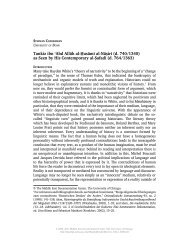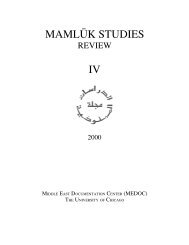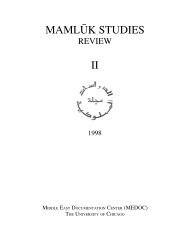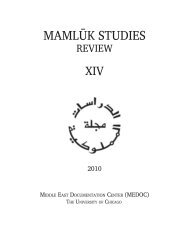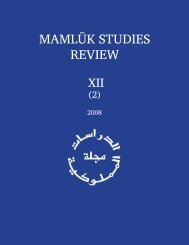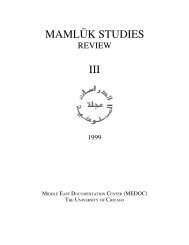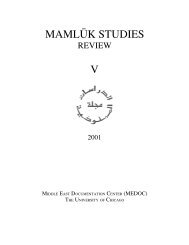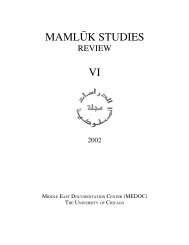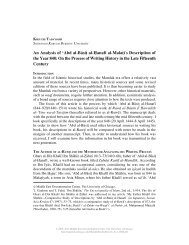Vol. VIII, no. 2 (2004) - Mamluk Studies Review - University of Chicago
Vol. VIII, no. 2 (2004) - Mamluk Studies Review - University of Chicago
Vol. VIII, no. 2 (2004) - Mamluk Studies Review - University of Chicago
Create successful ePaper yourself
Turn your PDF publications into a flip-book with our unique Google optimized e-Paper software.
MAMLU±K STUDIES REVIEW VOL. 8, NO. 2, <strong>2004</strong> 11<br />
Upper Egypt redistributed the village lands annually, according to the tillage<br />
rights <strong>of</strong> individual households or clans, with the aim <strong>of</strong> equalizing the effects <strong>of</strong> a<br />
bad harvest. 40 Indeed, according to an anecdote told by al-Na≠bulus|, the lands <strong>of</strong><br />
the village <strong>of</strong> Saylah were redistributed periodically among the cultivators. 41 In the<br />
h˝ad˝ar villages that relied on perennial irrigation such collective management <strong>of</strong><br />
production would <strong>no</strong>t have been necessary.<br />
The second major difference was that the inhabitants <strong>of</strong> Minyat al-Usquf were<br />
predominantly Christians while the badw villagers <strong>of</strong> Saylah were predominantly<br />
Muslim. All in all, 1,142 adult <strong>no</strong>n-Muslim men were registered as living in the<br />
province <strong>of</strong> the Fayyum. 42 Of these, about half lived in eight predominantly Christian<br />
h˝ad˝ar villages, which accounted for less than 10% <strong>of</strong> the total number <strong>of</strong> villages<br />
in the province. 43 The Christian h˝ad˝ar inhabitants <strong>of</strong> these villages were the only<br />
people in rural Fayyum without tribal affiliation or claim to Arab genealogy, the<br />
only ones excluded from the otherwise all-encompassing badw identity. In addition,<br />
about five hundred Christian men liable for the poll-tax were unevenly spread<br />
among the far more numerous badw villages, at an average <strong>of</strong> about five per<br />
village. In Saylah, for example, ten adult <strong>no</strong>n-Muslim men and their families lived<br />
in the midst <strong>of</strong> the Muslim badw majority.<br />
Unlike the h˝ad˝ar|s, the badw had the right to bear arms, a privilege obviously<br />
reserved to Muslims. Some <strong>of</strong> the Arab tribesmen must have been armed during<br />
peacetime, since we are told that Arab tribesmen guarded, and possibly harassed,<br />
the few Christian h˝ad˝ar villages. 44 Al-Na≠bulus| also tells us that the Arab tribes <strong>of</strong><br />
40 Kenneth Cu<strong>no</strong>, The Pasha's Peasants: Land, Society, and Eco<strong>no</strong>my in Lower Egypt, 1740–1858<br />
(Cambridge, 1992), 66; idem, "Origins <strong>of</strong> Private Ownership <strong>of</strong> Land in Egypt," International<br />
Journal <strong>of</strong> Middle East <strong>Studies</strong> 12 (1980): 246. Poliak has already suggested that village lands<br />
were periodically redistributed in the <strong>Mamluk</strong> period, but on rather slim evidence ("Some Notes<br />
on the Feudal System <strong>of</strong> the <strong>Mamluk</strong>s," Journal <strong>of</strong> the Royal Asiatic Society [1937]: 104–5).<br />
41 Al-Na≠bulus| relates, in the context <strong>of</strong> an anecdote about a locality in Saylah allegedly blessed by<br />
the Prophet Jacob, that "whenever this plot <strong>of</strong> land falls in someone's field through distribution<br />
(bi-al-qismah), the yield <strong>of</strong> the field increases by 100 irdabbs" (Ta≠r|kh al-Fayyu≠m, 114). I take this<br />
sentence to mean that the same plot <strong>of</strong> land rotated between different cultivators according to<br />
some form <strong>of</strong> a periodic draw.<br />
42 But about a quarter <strong>of</strong> these 1,142 <strong>no</strong>n-Muslim men were regarded as absentees (na≠’u≠n), that is,<br />
men who left their original village and <strong>no</strong>w dwelled in a<strong>no</strong>ther village, either in the Fayyum or in<br />
a<strong>no</strong>ther province. On this fiscal category <strong>of</strong> absentees, see also al-Nuwayr|, Niha≠yat al-Arab,<br />
8:244.<br />
43 Apart from the five villages already mentioned (Abu≠ Kisa≠, Ba≠jah, Bamu≠yah, Minyat al-Usquf,<br />
and Munsha’at Awla≠d ‘Arafah), other predominantly Christian and h˝ad˝ar villages were Dimashqyan<br />
al-Bas˝al, Sinnu≠ris and Dha≠t al-S˛afa≠’.<br />
44 Qala≠wu≠n's memorandum to Kitbugha≠, dated 679/1281, specifically prohibits the ‘urba≠n from<br />
carrying weapons <strong>of</strong> any kind when traveling from village to village (Sato, State and Rural<br />
© <strong>2004</strong>, 2012 Middle East Documentation Center, The <strong>University</strong> <strong>of</strong> <strong>Chicago</strong>.<br />
http://mamluk.uchicago.edu/<strong>Mamluk</strong><strong>Studies</strong><strong>Review</strong>_<strong>VIII</strong>-2_<strong>2004</strong>.pdf



